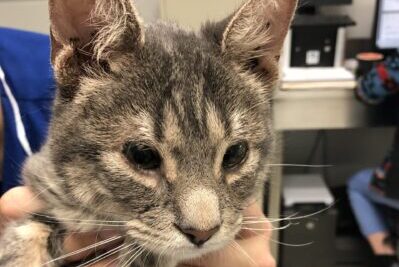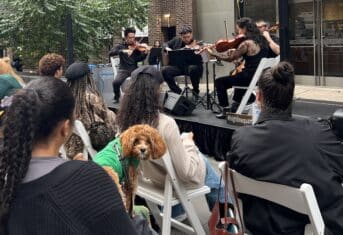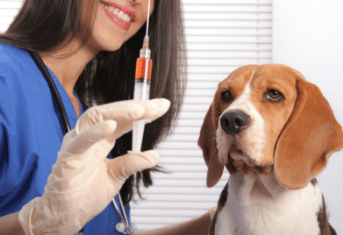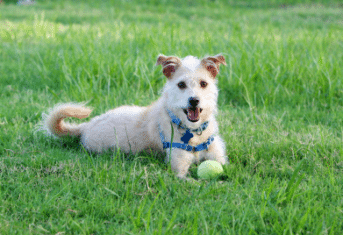Anesthesia in Veterinary Dental Care
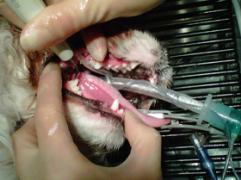
Anesthesia in Veterinary Dental Care
When people go to a human dentist, we sit in the dentist’s chair, often time grasping the armrests tightly with white knuckles in anticipation of the procedure about to happen. When the dentist or hygienist tells us to say “ahhhhhhhh” or turn our head, or open our mouths, we may be reluctant, but we can follow their directions to facilitate their work. When they place x-ray films or digital sensors in our mouths and tell us to hold them while they walk out of the room, we do as they say.
The photo shows a dog under general anesthesia having its teeth scaled. You can see the “breathing tube” inserted in the mouth and attached to an anesthesia machine.
February is Veterinary Dental Month. Our pets need the same dental care as we do; maybe more, since they don’t brush or floss twice a day. Our pets are not as cooperative when it comes to saying “ahhhhhhhh” or when it comes to following directions, yet they often experience the same anxiety as their owners when a stranger is poking and squirting things around their mouths.
There has been recent movement to perform anesthesia-free dental cleanings on veterinary patients. The rationale for performing dentistry on awake dogs and cats is that it will be cheaper for the client and safer for the patient. This movement is in direct opposition to the American Veterinary Dental College’s position statement entitled, “Companion Animal Dental Scaling without Anesthesia.”
I understand that many people are reluctant to perform proper dental procedures because of the need for general anesthesia, especially in the older patient. I am a firm believer that “age is not a disease,” and age should not be the deciding factor in determining the safety of general anesthesia for any patient. Pre-anesthesia testing can help determine the risk associated with general anesthesia and aid in the decision whether or not to perform a dental procedure. These tests help determine the function of the internal organs such as the liver, kidneys, heart and lungs, which are necessary to help the body safely handle anesthesia.
Proper anesthesia starts with the pre-op testing but also involves choosing the proper anesthetic drugs safest for each pet. The Animal Medical Center’s Dental Service always places an intravenous catheter to administer drugs, fluids and emergency drugs if needed. We also place an endotracheal, or breathing, tube to protect the airway and deliver the anesthetic gas and oxygen mixture to the lungs. Anesthetized dogs and cats at the AMC are connected to various monitoring equipment to measure the vital signs such as pulse rate, blood oxygen levels, blood pressure, electrocardiogram, and carbon dioxide levels. Finally, we monitor at regular intervals to make sure the vital signs are stable. If any painful procedures need to be performed, we also have the ability to utilize local anesthesia to minimize the amount of general anesthesia needed.
There are many advantages to performing any dental procedures under general anesthesia. First, when we scale the calculus (also known as tartar) off the teeth, there are often large or small pieces of calculus removed. If an animal is properly intubated with a breathing tube, then this calculus cannot be aspirated into the lungs or “swallowed down the wrong pipe.” The biggest advantage to working on a patient under general anesthesia is the ability to work around every side of every tooth. In the awake patient, the veterinary dentist has a very limited view of most of the teeth in the mouth. It’s easy to see the outside of the front teeth, but virtually impossible to evaluate the inside surfaces of many teeth and impossible to see many of the back teeth. A proper cleaning involves cleaning off all of the calculus from every surface of every tooth, both above and below the gum line. In the awake patient, the area below the gum line cannot be seen, yet under anesthesia it is much easier to fully visualize this area.
Once the teeth are cleaned, they need to be evaluated for periodontal disease. This involves gently probing under the gum line in several areas around each tooth in the mouth to measure periodontal pockets, or separation of the gums from the tooth root surface. Imagine trying to do this in an awake dog.
Approximately 75% of cats presenting for dental procedures have a decay of their teeth called tooth resorption. These are holes or decay in the teeth that often start at the gum line. They are quite painful and diagnosed by probing along the gum line with an instrument called an explorer. Again, this is not the type of procedure that could be tolerated by a cat without general anesthesia.
Proper dental procedures require intra-oral x-rays to make a diagnosis. A piece of film or a digital x-ray sensor is placed in the pet’s mouth. The person taking the x-ray steps out of the room and exposes the film or sensor and then walks back in the room. Not too many awake pets will tolerate this type of procedure.
Finally, with 75% of cats having tooth resorption and 80% of all dogs over the age of 5 years having periodontal disease, most veterinary dental patients need some type of surgical procedure to correct the abnormality. Finally, it is much easier to perform oral surgery when I’m not working on a moving target.
Given the complexity of the procedures necessary to clean, diagnose and treat a pet’s mouth, it is easy to understand why general anesthesia is so vital to performing proper veterinary dental care. My recommendation to anxious pet owners over the years is to use a little general anesthesia every year in order to maintain a healthy mouth, rather than wait until the mouth has severe disease and needs several hours of surgery to clean up a messy and painful mouth.
This blog may also be found in the “Tales from the Pet Clinic” blog from WebMD.
________________________________________________
For over a century, The Animal Medical Center has been a national leader in animal health care, known for its expertise, innovation and success in providing routine, specialty and emergency medical care for companion animals. Thanks in part to the enduring generosity of donors, The AMC is also known for its outstanding teaching, research and compassionate community funds. Please help us to continue these efforts. Send your contribution to: The Animal Medical Center, 510 East 62nd Street, New York, NY 10065. For more information, visit www.amcny.org. To make an appointment, please call 212.838.7053.































